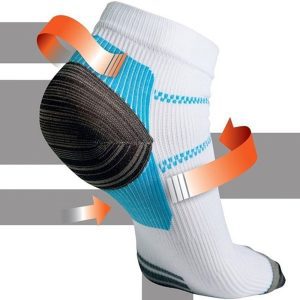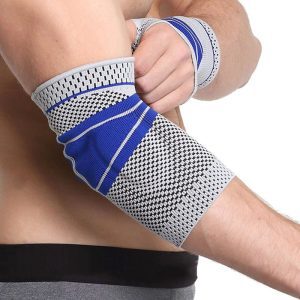Diabetic Neuropathy is a complication of diabetes. Diabetics who experience this disease typically suffer from damage to the nerves in their feet and hands that causes pain, tingling, or numbness. In this article we will look at the causes and symptoms of diabetic neuropathy as well as some treatment options for those who have been diagnosed with it.
What is diabetic neuropathy?
Diabetes can damage your nerves. The result of this damage is called Neuropathy. And unfortunately, this damage can be very painful.
Diabetes patients have higher blood sugar levels (glucose levels) and in most cases higher levels of fat as well. An example here is triglycerides. In combination, high glucose and fat levels damage your nerves over time.
Symptoms
Today’s medicine knows four main types of diabetic neuropathy. You can have just one type or more than one of them.
Symptoms depend on the type of neuropathy that you have and which nerves are affected. In general we see symptoms developing gradually over time and many people don’t notice that anything is wrong until the damage is done.
Here are the four main types of diabetic neuropathy:
1. Peripheral Neuropathy
Peripheral neuropathy is a form of nerve damage that primarily affects the feet and legs, although it can also affect the hands and arms. This sort of neuropathy is fairly common. Between one-third and one-half of persons with diabetes suffer from peripheral neuropathy. Signs and symptoms of peripheral neuropathy occur during days, but get often worse at night. They include:
- Numbness and tingling
- The reduced ability to feel pain
- Burning sensations
- Cramps and sharp pain
- The inability to feel temperature changes
- Serious foot problems (infections, bone and joint pain)
- Increased sensitivity
2. Autonomic Neuropathy
Damage to nerves that control your internal organs, known as autonomic neuropathy, includes the following symptoms:
- Problems with heart rate
- Blood pressure problems
- Bloating and feeling full after meals
- Vomiting and nausea caused by slow stomach emptying
- Eye problems adjusting from light to dark
- Decreased sexual response
3. Mononeuropathy (focal neuropathy
Focal neuropathies are disorders that damage a single nerve, most frequently the hand, head, torso, or leg. Carpal tunnel syndrome is one form of entrapment syndromes. Other types of focal neuropathy are far less common. Mononeuropathy can lead to the following conditions:
- Aching behind the eyes (one eye only)
- Double vision and difficulty focusing
- One side of the face paralyzed (Bell’s palsy)
- Tingling in your hand and fingers or numbness
- Grip problems and weakness in your hands
4. Proximal Neuropathy
Proximal neuropathy is a rare and severe form of nerve damage in your hip, buttock, or thigh that affects only one side of the body. The damage usually harms only one side of your body and may occasionally spread to the other. Symptoms gradually subside over time and include:
- Difficulty getting up or rising from a sitting position
- Severe pain in the stomach
- Pain in one side of the hip and thigh or buttock
- Potentially shrinking and weak muscles
When to see a doctor
You should not waste any further time and contact your doctor if you have:
- An infected cut or sore on your foot that doesn’t heal
- Problems in your daily life through burning, tingling, pain or weakness in your hands or feet
- Digestive changes and problems with urination or sexual functions
- Dizziness and fainting
- Pain behind one eye or double vision that lasts for over a day
- Paralysis of one side of your face
Immediately after you have been diagnosed with toe 2 diabetes you should begin screening, according to the American Diabetes Association. If you have type 1 diabetes, you should begin screening after 5 years after that diagnosis. After the initial screening, it is recommended annually.
Causes
Scientists and researchers think that uncontrolled high blood sugar is the culprit that damages nerves and limits their ability to send signals over time. However, the exact cause of each of the four types is still unknown.
Who is at risk?
Everyone with diabetes can develop one or more types of neuropathy. The following risk factors favor the development though:
- Your diabetes history. If you’ve had diabetes for a long time, regardless of your blood sugar levels in the past, you’re at increased risk.
- Your age . As you get older, your risk increases. You probably have more damaged nerves with age than someone who is younger.
- Poor blood sugar level control. You have a higher risk if you have poor blood sugar level control.
- Kidney conditions. If your kidneys don’t work properly, you’ll have higher levels of sugar in your blood. This can contribute to nerve damage.
- Smoking. We know that smoking narrows and hardens your arteries. That reduces blood flow to your extremities and makes it more difficult for wounds to heal and peripheral nerves get damaged.
- Your body weight. You might be at increased risk if you carry excess weight around your waist. Everyone with a BMI of 25 or above is at increased risk.
Diagnosis
The first step to diagnosing diabetic neuropathy is an physical exam. Your doctor will check your overall muscle strength and tone, your tendon reflexes and the sensitivity to touch. Along with this physical exam and your medical history and symptoms there are specific tests that help diagnose diabetic neuropathy. These test are the most used ones:
- Autonomic testing. Measuring how your blood pressure changes in different positions and how your sweat levels change.
- Nerve conduction testing. You’ll sit or lie down on a table. Your doctor will touch your skin with the handheld tool called an electrode to send small electrical impulses through your body and measure how quickly they travel along certain nerves.
- Sensory test. Your doctor will use a small piece of cotton or nylon to touch an area on your leg and ask if it feels normal, sharp or painful.
- Temperature testing. This is a noninvasive test and shows how your nerves react to changes in temperature.
- Filament test. Your doctor will ask you to sit or lie down. He may touch your feet with a small nylon filament and ask if it feels normal when it’s pressed lightly on the soles of your feet.
- Muscle responsiveness test. Your doctor may have you do several exercises to check the strength in your feet, legs and hands. This gives him clues about how nerve signals are getting through to your muscles.
Treatment & Pain Relief
Unfortunately there is no known cure to diabetic neuropathy. So the goals of treatment are to slow down the progression of the disease, relieve pain from neuropathy and to restore functions and manage the complications.
Keeping your blood sugar levels within your target range is key. Proper management of your blood sugar level may already improve your symptoms. Please always check your blood sugar levels with your doctor to figure out the best target range for you based on your individual needs and factors.
The second most important thing to prevent neuropathy from getting worse is to keep your blood pressure under control. You probably know that high blood pressure can damage blood vessels. That applies to your peripheral nerves, too. The sooner you get it under control the better for your nerves.
Engage in physical activity and maintain a healthy weight. This is usually a good way to help with pain and nerve damage. You may need to talk to your doctor or nurse first before starting an exercise program to make sure it’s safe for you.
There are many prescription medications available for diabetes-related pain. But this is a highly individual topic and what works for one doesn’t work for the other. When you consider any medication, please talk to your doctor about the options, benefits and possible side effects. That way you have the best chances to find something that works for you.
In some cases, an antidepressant is combined with an anti-seizure drug. Some antidepressants ease nerve pain and are helpful, even if your not depressed. Over-the-counter medication such as Tylenol, Ibuprofen or skin patches with Lidocaine do the trick as well.
Restoring function
If you have various complications, you may need to consult different specialists, such as an urologist for urinary problems and a cardiologist for heart problems. Here are the most common functions that can be restored or managed:
- Sexual dysfunction. Some medications improve sexual function, but there are side effects and they don’t work for everyone. Mechanical devoices may increase blood flow and do the trick too. For women there are vaginal lubricants that promise relief.
- Digestive issues. Eating smaller and more frequent meals is the most recommended method dealing with symptoms of gastroparesis, indigestion, belching, nausea and vomiting. Changes in your diet help with these problems as well.
- Urinary tract problems. In some cases, gentle massage to the bladder already helps. A urination schedule is something that can get bladder and urination issues under control. Another method that may be needed to help remove urine from a nerve-damaged bladder is self-catheterization.
- Low blood pressure. This requires lifestyle changes. Avoiding alcohol and drinking plenty of water is absolutely mandatory. If you need to change positions, do it slowly. You may want to raise the head of the bed by a few inches to prevent swings in blood pressure and compression supports are usually a good way to get started.
Home remedies
There are various things you can implement into your daily routines to reduce the risk of diabetic neuropathy and make your life better. Here are some ideas:
- Control your blood pressure. High blood pressure in combination with diabetes leads to even greater risks of complication. Keep your blood pressure in the range that your doctor recommends and be sure to check it at least twice a day at home.
- Change your diet. Eat healthy food. Vegetables, fruits and whole grains are especially good for you. But be sure to eat smaller portions more frequently to prevent bloating, vomiting and diarrhea.
- No smoking please. Tobacco in any form causes poor circulation in your feet and hands. If you cannot stop smoking, make sure to talk this over with your doctor at least. He may give you some valuable tips on how to quit.
- Get active. Exercise and movement is great to lower blood sugar levels. If you get active daily, this improves your blood flow and keeps your heart healthy. 150 minutes are recommended each week for most adults. But be sure to talk with your therapist or doctor before you try a new exercise plan. Take it slow first.
Foot care
Sinne this article is part of our foot pain series, I don’t want to leave foot care untouched. Common complications of diabetic neuropathy include ulcers, sores that don’t heal and even amputation in some cases. The good news is that you can prevent most of these problems. And besides having a foot exam annually, here are some things that you can do at home yourself:
- Choose shoes that fit well. While this may sound trivial, when you have neuropathy you should be very careful when buying shoes. High heels are a no-go for starters and the best shoes to wear are ones that are cushioned well. This helps to prevent corns and calluses too.
- Trim your toenails regularly. Avoid sharp edges and file the edges carefully.
- Check your feet daily. Examine your feet for blisters, cuts, bruises, peeling skin and swelling every day.
- Moisturize your feet. Using a moisturizing cream is a great way to prevent dry skin. It also reduces the risk of corns and calluses and keeps your feet soft and smooth.
- Keep your feet dry. You should dry your feet very well after a shower or bath. Use a hair dryer if you do not have time to dry them naturally and pay attention to the areas between your toes to avoid fungal growth.
- Wear the right type of socks. Avoid tight fitting socks and look for ones made of cotton or other moisture wicking materials.
Alternative medicine
You may want to try alternative medicine therapies either on their own or in combination with medications. But please check this with your doctor before you get involved. Here are the most success promising alternative therapies:
- Acupuncture. This involves placing tiny needles into specific points in your body. The goal is to unblock any obstructions that may be causing the pain and numbness.
- Massage therapy. Massaging can help reduce nerve damage when done regularly. It also helps with stress reduction which is important as well, because elevated stress levels worsen neuropathic symptoms.
- Capsaicin. This is a cream that you apply directly to the skin. It works by depleting your nerves of a chemical called “Substance P” which can cause pain and swelling.
- Yoga and meditation. Yoga focuses on breathing techniques, posture and relaxation. Meditation on the other hand is all about focusing on your thoughts and controlling them in a healthy way.
- Alpha-lipoic acid. This is a very powerful antioxidant. You can find this antioxidant in foods such as carrots, beets, spinach, broccoli and potatoes. But there are supplements out there that can help as well.
- Acetyl-L-carntine. This nutrient eases nerve pain in some people. You can get it as a supplement.
- Transcutaneous electrical nerve stimulation. Most often called just TENS. Tiny electrical impulses stimulate your brain and help prevent pain signals from reaching their destination.
Do you suffer from diabetic neuropathy? Do you want to learn about the causes, symptoms and treatment options for this condition? If so, we hope that reading our article “Diabetic Neuropathy – Diagnosis & Treatment Options” will have helped answer some of your questions or at least given you a starting point for more research. To continue learning about how compression sleeves can help with pain relief please browse through our website’s product section. And if we’ve missed any helpful tips in this blog post please comment below!























One Response
Thank you to share these important information about diabetic neuropathy. I have a sister and she suffering from peripheral diabetic neuropathy for many years and so far there was no medicine to reduce the intensity of pain of her body. Recently, she has been given a suggestion to apply some kind of magnetic waves around her head to cure!? and reduce the pain.
Have you got any information about this type of treatment?
I appreciate all your kind help.
With best regards,
Habib Alimohammadian